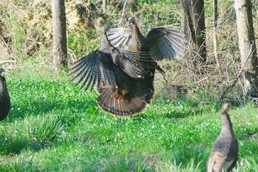Symphony of the Wild
SHARE THIS POST
The world of the whitetail hunter is rich with sounds—some interesting, some entertaining, some unknown and some telltale.
Some of the most common sounds heard by those of us who hunt whitetails in Minnesota’s northern forests are made by red squirrels. One of the first sounds heard every morning, usually at first light, is the soft, lengthy chirr of a red squirrel.
Some years ago, while seated at a ground-level stand site, a passing red squirrel halted on a birch log a few inches from my boots, sat back on its hind legs, formed a dime-sized hole with its lips and chirred. So that’s how they do it, I remember thinking. Though some red squirrels have actually forced me to abandon stand sites because of their irate wheezing and barking, informing every deer with 200 yards of my presence, most red squirrels I have known were well behaved and some even some even turned out to be buck-hunting allies.
Take the time I was well into the third mile of tracking a wounded buck that had been hit by fragments from my 7 mm Magnum bullet after it passed through a young, intervening ash tree. I was resting on an embankment next to a large clump of mature spruce trees when it suddenly occurred to me a red squirrel was excitedly barking at something on the opposite side of the evergreens. Quickly grabbing my rifle, I ran as fast as I could around the left side of the clump where I spotted the buck quartering away across a wooded hillside about 50 yards away. An easy heart shot put it down for good. At that point I could not help but shout, “Thank you, squirrel!”
My most recent red squirrel hunting ally resided in a burrow under the roots of a tree a few jumps to the right of a favorite natural blind. This blind is situated about 15 yards back in the woods from the edge of a brushy 3-year-old clear-cut. Not realizing it, by 8 a.m. I was beginning to doze, not an uncommon consequence of a long, boring surveillance at a stand site. Shortly, some soft clicking sounds of small paws racing across the long dead tree branch lying across the top of the enormous trunk of the fallen pine behind which I sat brought me back to my senses. The moment my eyes opened, a red squirrel with cheeks bulging with seeds from fallen pinecones halted less than 2 feet away to stare at me. Thanks for waking me, squirrel, I could not help thinking, blinking my eyes.
After it passed a few times during the following forty-five minutes, I raised up a bit to see if it was storing seeds in the same burrow it had used the year before. At that moment, however, the movement of another creature caught my attention: the buck I was expecting. It was one of the biggest I have ever seen in the wild. The main beams of its antlers were exceptionally wide, dark reddish-brown in color and they had more long tines on them than seen on the usual 10-pointer. It was walking toward me along the edge of the clear-cut about 80 yards away. Ducking down, I silently eased off the safety on my rifle, chambered for 7 mm Magnum (using 150 grain bullets), and slowly took aim beneath the squirrel’s crossing branch toward the center of the far end of the natural opening (about 10 feet wide, 60 yards long) before me, through which I expected the buck to pass.
Suddenly, there it was—standing broadside. The trouble was it was standing behind a dense patch of hazels just to the right of the opening and it was staring in my direction. With the breeze in my face, wearing my camo head net and otherwise being well hidden, the buck obviously could not identify me. Meanwhile, however, I had a dilemma. I knew from lessons learned the hard way, my fast-moving bullet was unlikely to pass unscathed through those thick hazels, likely blowing up or ricocheting before reaching the buck. The buck had a notably large, bright white throat patch that appeared to be relatively clear of intervening obstructions, however. That was fine with me; I have long preferred neck shots. Upon centering my scope on that throat patch and firing, however, the buck didn’t immediately drop to the ground as expected. Instead, it immediately leaped eastward and kept going. Following three quick glimpses, it disappeared.
After an hour of searching for signs of a hit and finding none, I returned to my blind. A few minutes later, the squirrel again stopped on its crossing branch to stare at me. “Too bad,” it seemed to say, “that was a huge buck.”
There are many other sounds that are commonly a part of deer hunting in northern Minnesota. One heard at first light almost every morning is the flute-like call of a gray jay, soon seen looping from branch to branch, accompanied by its mate. About the time the first rays of the sun begin stabbing through the crowns of distant trees along the eastern horizon, ravens flying overhead begin exchanging gruff croaks and caws, seemingly excited about sighting blaze-orange-clad humans in the forest below. Not long after sunrise, cherry calls of chickadees fill the air as families of them search for favorite foods close to the ground. Many deer hunters have never forgotten the moment one of these little woodland clowns have landed on their gun barrels or peeked at their faces from the bills of their caps, singing their characteristic greeting, “Chickadee-dee-dee!”
Are you enjoying this post?
You can be among the first to get the latest info on where to go, what to use and how to use it!
Ruffed grouse often brighten a long stand site vigilance as well. I still vividly recall being alerted of silent approaches being made by two big 10-pointers by grouse suddenly taking flight from from shallow burrows in snow before them.
Sounds made by whitetails, of course, are the essence of deer hunting. The growl-like or gurgling so-called grunt of a buck generates considerable excitement among veteran buck hunters in my camp. Such a sound usually means a nearby dominant breeding buck is warning a second buck to keep away from the doe in heat it is accompanying. If grunts are accompanied by blows or scrapes of antlers on wood, the sounds are being made by a mature buck battling a tree trunk (making or renewing an antler rub). If accompanied by sounds of rattling antlers, the sounds are two bucks fighting. Such sounds may even attract one or more other bucks.
Because I regularly hunt older bucks by stand-hunting downwind or crosswind within easy shooting range of feeding areas currently favored by does during the primary breeding phase of the rut (hoping one is in heat), my ears are constantly alert to hearing subtle sounds made by feeding deer. These sounds are twig snaps normally too soft to arouse much, if any interest. They are generally heard singularly, often several minutes apart, made by a deer biting off stems of woody shrubs (browse) such as red osiers, mountain maples and sugar maple saplings. By patiently watching for movements in the direction from which such sounds are originating, you are likely to be soon rewarded with the sight of a feeding deer.
Much-anticipated parts of the charm of the region where I hunt whitetails include sounds that begin at sundown—howls of wolves beginning the nocturnal symphony. Today, we commonly hear our wolves howl during daylight hours as well, which was formerly very unusual. Their howls are most common at night, often arousing us from our slumbers in deer camp. The most exciting of such nights—actually somewhat hair-raising—was the one during which our local pack made it obvious by their close and wild howling they intended to pull down the big 10-pointer hanging behind our tent.
Other interesting sounds at night include those made by owls. ”Who cooks for you?” barred owls incessantly inquire. Great gray owls keep it simple, merely asking, “Whooo?” Also, saw-whet owls softly screech and short-eared owls take delight in rousing us from sleep with horrendous imitations of packs of howling coyotes.
Imagine deer hunting without such sounds and others. Imagine how boring stand-hunting would be and how ineffective we stand hunters would be, likely falling asleep repeatedly throughout the day if the forests around us were not often filled with Mother Nature’s wild symphony.
Dr. Ken Nordberg has written more than 700 magazine articles and 12 books on the habits and hunting of whitetails and black bears, ncluding the “Whitetail Hunters Almanac” series. He also produced “Doc’s Buck and Bear Hunting School” videos. His encyclopedic website is at drnordbergondeerhunting.com.
MWO
SHARE THIS POST
Did you enjoy this post?
You can be among the first to get the latest info on where to go, what to use and how to use it!
Dr. Ken Nordberg
Based on his 55 years of field research, Dr. Ken Nordberg has written more than 800 magazine articles, 12 books on whitetails—including the famous Whitetail Hunter’s Almanac series—five books on black bear hunting and produced Buck and Bear Hunting School videos. You may peruse his encyclopedic website with whitetail hunting tips: drnordbergondeerhunting.com, his blog: drnordbergondeerhunting.wordpress.com, or social media pages.



